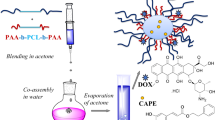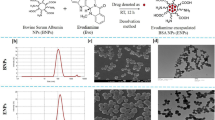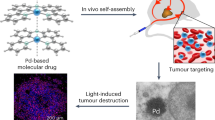Abstract
When designing drug carriers, the drug-to-carrier ratio is an important consideration, because the use of high quantities of carriers can result in toxicity as a consequence of poor metabolism and elimination of the carriers1. However, these issues would be of less concern if both the drug and carrier had therapeutic effects. (−)-Epigallocatechin-3-O-gallate (EGCG), a major ingredient of green tea, has been shown, for example, to possess anticancer effects2,3,4,5,6,7, anti-HIV effects8, neuroprotective effects9 and DNA-protective effects10. Here, we show that sequential self-assembly of the EGCG derivative with anticancer proteins leads to the formation of stable micellar nanocomplexes, which have greater anticancer effects in vitro and in vivo than the free protein. The micellar nanocomplex is obtained by complexation of oligomerized EGCG with the anticancer protein Herceptin to form the core, followed by complexation of poly(ethylene glycol)–EGCG to form the shell. When injected into mice, the Herceptin-loaded micellar nanocomplex demonstrates better tumour selectivity and growth reduction, as well as longer blood half-life, than free Herceptin.
This is a preview of subscription content, access via your institution
Access options
Subscribe to this journal
Receive 12 print issues and online access
$259.00 per year
only $21.58 per issue
Buy this article
- Purchase on Springer Link
- Instant access to full article PDF
Prices may be subject to local taxes which are calculated during checkout




Similar content being viewed by others
References
Allen, T. M. & Cullis, P. R. Drug delivery systems: entering the mainstream. Science 303, 1818–1822 (2004).
Cao, Y. & Cao, R. Angiogenesis inhibited by drinking tea. Nature 398, 381 (1999).
Jankun, J., Selman, S. H., Swiercz, R. & Skrzypczak-Jankun, E. Why drinking green tea could prevent cancer. Nature 387, 561 (1997).
Tachibana, H., Koga, K., Fujimura, Y. & Yamada, K. A receptor for green tea polyphenol EGCG. Nature Struct. Mol. Biol. 11, 380–381 (2004).
Liang, G. et al. Green tea catechins augment the antitumor activity of doxorubicin in an in vivo mouse model for chemoresistant liver cancer. Int. J. Oncol. 37, 111–123 (2010).
Garbisa, S. et al. Tumor invasion: molecular shears blunted by green tea. Nature Med. 5, 1216 (1999).
Du, G. J. et al. Epigallocatechin gallate (EGCG) is the most effective cancer chemopreventive polyphenol in green tea. Nutrients 4, 1679–1691 (2012).
Li, S., Hattori, T. & Kodama, E. N. Epigallocatechin gallate inhibits the HIV reverse transcription step. Antivir. Chem. Chemother. 21, 239–243 (2011).
Yu, J. et al. Epigallocatechin-3-gallate protects motor neurons and regulates glutamate level. FEBS Lett. 584, 2921–2925 (2010).
Morley, N. et al. The green tea polyphenol (–)-epigallocatechin gallate and green tea can protect human cellular DNA from ultraviolet and visible radiation-induced damage. Photodermatol. Photoimmunol. Photomed. 21, 15–22 (2005).
Miyata, K., Christie, R. J. & Kataoka, K. Polymeric micelles for nano-scale drug delivery. React. Funct. Polym. 71, 227–234 (2011).
Musacchio, T. & Torchilin, V. P. Recent developments in lipid-based pharmaceutical nanocarriers. Front. Biosci. 16, 1388–1412 (2011).
Duncan, R. The dawning era of polymer therapeutics. Nature Rev. Drug Discov. 2, 347–360 (2003).
Hubbell, J. A. Materials science. Enhancing drug function. Science 300, 595–596 (2003).
Kopecek, J. & Kopeckova, P. HPMA copolymers: origins, early developments, present, and future. Adv. Drug Deliv. Rev. 62, 122–149 (2010).
Duncan, R. Polymer conjugates as anticancer nanomedicines. Nature Rev. Cancer 6, 688–701 (2006).
Farokhzad, O. C. et al. Nanoparticle–aptamer bioconjugates: a new approach for targeting prostate cancer cells. Cancer Res. 64, 7668–7672 (2004).
Miura, Y. et al. Cyclic RGD-linked polymeric micelles for targeted delivery of platinum anticancer drugs to glioblastoma through the blood–brain tumor barrier. ACS Nano 7, 8583–8592 (2013).
Cabral, H. et al. Targeted therapy of spontaneous murine pancreatic tumors by polymeric micelles prolongs survival and prevents peritoneal metastasis. Proc. Natl Acad. Sci. USA 110, 11397–11402 (2013).
Wang, F. et al. Selective tissue distribution and long circulation endowed by paclitaxel loaded PEGylated poly(epsilon-caprolactone-co-L-lactide) micelles leading to improved anti-tumor effects and low systematic toxicity. Int. J. Pharm. 456, 101–112 (2013).
Harris, J. M. & Chess, R. B. Effect of pegylation on pharmaceuticals. Nature Rev. Drug Discov. 2, 214–221 (2003).
Kim, D., Gao, Z. G., Lee, E. S. & Bae, Y. H. In vivo evaluation of doxorubicin-loaded polymeric micelles targeting folate receptors and early endosomal pH in drug-resistant ovarian cancer. Mol. Pharmacol. 6, 1353–1362 (2009).
Ishii, T. et al. Treatment of cerebral ischemia-reperfusion injury with PEGylated liposomes encapsulating FK506. FASEB J. 27, 1362–1370 (2013).
Yang, C. S. & Wang, Z. Y. Tea and cancer. J. Natl Cancer Inst. 85, 1038–1049 (1993).
Kuzuhara, T., Sei, Y., Yamaguchi, K., Suganuma, M. & Fujiki, H. DNA and RNA as new binding targets of green tea catechins. J. Biol. Chem. 281, 17446–17456 (2006).
Chung, J. E., Kurisawa, M., Kim, Y. J., Uyama, H. & Kobayashi, S. Amplification of antioxidant activity of catechin by polycondensation with acetaldehyde. Biomacromolecules 5, 113–118 (2004).
Saucier, C., Guerra, C., Pianet, I., Laguerre, M. & Glories, Y. (+)-Catechin-acetaldehyde condensation products in relation to wine-ageing. Phytochemistry 46, 229–234 (1997).
Jobstl, E., O'Connell, J., Fairclough, J. P. & Williamson, M. P. Molecular model for astringency produced by polyphenol/protein interactions. Biomacromolecules 5, 942–949 (2004).
Villalba, J. J. & Provenza, F. D. Preference for polyethylene glycol by sheep fed a quebracho tannin diet. J. Anim. Sci. 79, 2066–2074 (2001).
Hisaka, T. et al. Interferon-αCon1 suppresses proliferation of liver cancer cell lines in vitro and in vivo. J. Hepatol. 41, 782–789 (2004).
Choi, H. S. et al. Synthesis and in vivo fate of zwitterionic near-infrared fluorophores. Angew. Chem. Int. Ed. 50, 6258–6263 (2011).
Chou, T. C., Motzer, R. J., Tong, Y. & Bosl, G. J. Computerized quantitation of synergism and antagonism of taxol, topotecan, and cisplatin against human teratocarcinoma cell growth: a rational approach to clinical protocol design. J. Natl Cancer Inst. 86, 1517–1524 (1994).
Sun, J. et al. Antitumor efficacy of a novel class of non-thiol-containing peptidomimetic inhibitors of farnesyltransferase and geranylgeranyltransferase I: combination therapy with the cytotoxic agents cisplatin, taxol, and gemcitabine. Cancer Res. 59, 4919–4926 (1999).
Acknowledgements
This research was funded by the Institute of Bioengineering and Nanotechnology (Biomedical Research Council, Agency for Science, Technology and Research, Singapore) and the National Institutes of Health (NIBIB grant no. R01-EB-011523, to H.S.C.). The authors thank A. Yamashita and J.P.K. Tan for their assistance with cell culture and TEM experiments, respectively.
Author information
Authors and Affiliations
Contributions
J.E.C. and M.K. conceived and designed the experiments. J.E.C., S.T., N.Y. and S.J.G. performed the experiments. S.H.K., J.H.L. and H.S.C. performed experiments and analysed data regarding biodistribution and pharmacokinetics. H.Y. provided HAK-1B cells. J.E.C. and M.K. reviewed, analysed and interpreted the data. J.E.C., S.T., H.S.C., M.K and J.Y.Y wrote the paper. All authors discussed the results. J.E.C. and M.K. supervised the project.
Corresponding authors
Ethics declarations
Competing interests
The authors declare no competing financial interests.
Supplementary information
Supplementary information
Supplementary Information (PDF 5278 kb)
Rights and permissions
About this article
Cite this article
Chung, J., Tan, S., Gao, S. et al. Self-assembled micellar nanocomplexes comprising green tea catechin derivatives and protein drugs for cancer therapy. Nature Nanotech 9, 907–912 (2014). https://doi.org/10.1038/nnano.2014.208
Received:
Accepted:
Published:
Issue Date:
DOI: https://doi.org/10.1038/nnano.2014.208
This article is cited by
-
Metal-enriched HSP90 nanoinhibitor overcomes heat resistance in hyperthermic intraperitoneal chemotherapy used for peritoneal metastases
Molecular Cancer (2023)
-
Protein@PP-Zn nanocomplex assembled by coordination of zinc ions used for intracellular protein delivery
Science China Chemistry (2023)
-
Preparation of FK-SA conjugate gel beads with double cross-linking for pH-controllable drug releasing
Polymer Bulletin (2023)
-
Bone marrow-targetable Green Tea Catechin-Based Micellar Nanocomplex for synergistic therapy of Acute myeloid leukemia
Journal of Nanobiotechnology (2022)
-
The embodiment of the strategy of “using active chemicals as excipients” in compound preparation
Journal of Pharmaceutical Investigation (2022)



